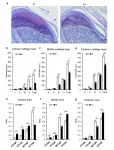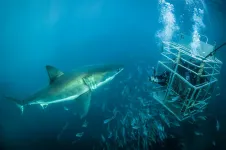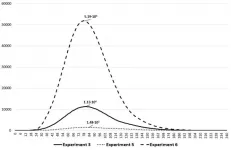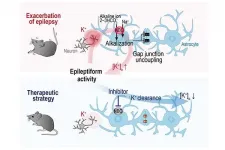(Press-News.org) Making cheese leaves a lot to chance as a batch could be ripened for months or even years before a problem is discovered, which could send a prized batch of cheddar to be sold off cheap as an ingredient for processed cheese.
It's part of why cheese is so complex and expensive to make - a factory could invest lots of time and money into what they think will be a top-graded batch, only to discover it's a flop when it's too late to fix.
But new research from RMIT University in Melbourne, Australia allows quality to be checked much earlier and more precisely in the process, giving manufacturers a better chance to react to issues with the ripening process.
Dr Roya Afshari said the team devised a method to expose cheese's biomarkers - or fingerprints - to show unique combinations of things like chemicals and milk-derived components that make up the perfect block.
"Once we know the chemical profile of a successful cheese, we can compare it to new batches as soon as 30 days into the ageing process," she said.
"It's like a pregnancy screening test for cheese - we analyse the biological data early in the development to see if there are any red flags.
"This could be done alongside traditional analyses like tasting to highlight future potential problems."
The team looked at different commercial cheddar cheeses in Australia and applied multi-omics - a kind of biological analysis typically used in human medicine to detect diseases early.
Researchers studied the biological make up of different brands and grades of cheese and worked with data experts to interpret and compare the results for known batches.
"Once we knew the unique properties of a finished cheese, we compared them to ripening batches and worked out which compounds distinguished the best cheeses," Afshari said.
With larger datasets, it will be possible for these techniques to let manufacturers know if their batch will age properly, because they can check to see if the key compounds have developed early in the ripening process or just as importantly that the bad ones haven't - like having a crystal ball.
What's more, the practice of grading a cheese's quality and maturity will no longer need to be left to subjective human senses.
Afshari said incorporating multi-omics analysis into testing cheese gives professional cheese graders more tools to accurately assess for quality.
"Cheese chemical fingerprints can be compared against those found in the perfect product, along with traditional grading methods.
"Now we can identify different types and grades of cheese more accurately than a taste test."
The researchers have published three recent studies demonstrating how interpreting the biological profile of cheese can aid manufacturing and grading.
In separate studies, they used multi-omics analyses to differentiate cheddar cheeses based on their age and brand, compare cheese of varying quality and group artisanal and industrial cheddar cheeses based on type and brand.
From cheese to wine
The method devised by the RMIT team is scalable and with more development could be used to test just about any food or beverage product, including wine, for quality and authenticity.
This is significant, as counterfeit wines are a multi-billion-dollar problem plaguing the industry.
Chief supervisor of this research project Professor Harsharn Gill said the days of counterfeit food and drink products could be numbered, as bioanalysis technology becomes commercially available.
"Some product's fingerprints are so unique and detailed that we can narrow down a sample to its origin," he said.
"Clues like the type of grapes used to the fermenting process can be answered by studying wine and comparing results to a trusted sample.
"We're still a long way off from having the technology affordable and therefore widely accessible but we're open to working with industry using facilities in the RMIT Food Research and Innovation Centre."
Led by Gill, RMIT researchers - including Professor Mark Osborn, Dr Daniel Dias and Dr Christopher Pillidge - are continuing development in this area, including investigating new ways to interpret the millions of data points extracted from food samples.
"As new tools become available, we'll have more power to inspect and interpret chemical data from food from many different angles, leading to more sustainable manufacturing," Gill said.
INFORMATION:
'Microbiota and metabolite profiling combined with integrative analysis for differentiating cheeses of varying ripening ages' is published in Frontiers in Microbiology
(DOI: 10.3389/fmicb.2020.592060).
'Biomarkers associated with cheese quality uncovered by integrative multi-omic analysis' is published in Food Control
(DOI: 10.1016/j.foodcont.2020.107752).
'New insights into cheddar cheese microbiota-metabolome relationships revealed by integrative analysis of multi-omics data' is published in Scientific Reports
(DOI: 10.1038/s41598-020-59617-9).
- Ends
Researchers from Tokyo Medical and Dental University (TMDU) observe underdeveloped jaw cartilage in newborn rats exposed to periods of low oxygen
Tokyo, Japan - Breathing in adequate amounts of oxygen is critical for human life. However, certain disorders can cause individuals to go through periods where they are exposed to periodical low levels of oxygen, called intermittent hypoxia (IH). This is common in people who suffer from some sleep disorders like obstructive sleep apnea. Although we know IH can cause neurological development issues, it is not clear how it affects cartilage. Now, researchers at Tokyo Medical and Dental University (TMDU) have shown that IH can result in underdeveloped jaw cartilage in rats.
In an article published in Scientific Reports, researchers ...
HIV infections are treated with antiviral drugs which effectively prevent the disease from developing. While pharmacological HIV therapy has advanced considerably, the virus cannot be entirely eliminated from the body with currently available drugs.
However, in roughly one-fifth of HIV patients the immune system does not recover as expected: the quantity of CD4 T cells, reflecting the status of the immune system, remains low even when the quantity of HI viruses in blood is suppressed to very low levels or below the measurement threshold. In such patients, indications of chronic immune activation, which erodes the immune system, can be detected.
In cooperation with the University of Erlangen-Nuremberg in Germany, researchers at the University of Helsinki have ...
Wildlife tourism including white shark cage-diving is growing in popularity, but these industries remain highly contentious amongst tourists, conservationists, and scientists alike.
Many voice concerns about possible negative impacts - especially when it targets potentially dangerous animals - while proponents cite the socio-economic benefits to justify wildlife tourism activities.
In reality, wildlife tourism is complex, requiring managers to balance the benefits and drawbacks to determine what is acceptable for such industries.
To help solve this question of "is wildlife tourism good or bad?", a tool to help managers assess these industries has been created ...
A painful tradeoff between a number of infected and negative economic impact must be considered before deciding on the lockdown strategy within a city. As national economies continue to crumble, citizens wonder whether their governments did a good job at regulating the lockdown measures.
Russian city of St. Petersburg is at the frontlines of this ongoing war with Covid-19. To combat this situation effectively, Russian government allocated significant funds for the research. Results followed. Scientists from Peter the Great St.Petersburg Polytechnic University (SPbPU) modified the existing SIR class pandemic prediction model. Now it is better.
But why? What is the nature ...
Breast cancer is the commonest fatal cancer in women. Early detection increases a woman's chances of recovery. Magnetic Resonance Imaging (MRI) is an accurate technique for detecting and classifying tumours in breast tissue. However, it sometimes causes "false alarms", thus requiring further investigation (biopsy) and in some cases even resulting in so-called overtreatment, that is to say unnecessary surgery. For the first time, a research team from MedUni Vienna has now confirmed a threshold value for a non-invasive imaging biomarker. This can be incorporated into short standard MRI scans ...
Without electronics and photonics, there would be no computers, smartphones, sensors, or information and communication technologies. In the coming years, the new field of phononics may further expand these options. That field is concerned with understanding and controlling lattice vibrations (phonons) in solids. In order to realize phononic devices, however, lattice vibrations have to be controlled as precisely as commonly realized in the case of electrons or photons.
Phononic cyrstals
The key building block for such a device is a phononic ...
Tohoku University scientists and their colleagues in Germany have revealed that a first-time exposure to only a brief period of brain hyperactivity resulted in an acute breakdown of the inter-cellular network of glial cells. Pharmacological intervention of the glial plasticity may provide a new preventative strategy for fighting epilepsy.
The findings were detailed in the Journal of Neuroscience.
Epilepsy is a disorder characterized by neuronal hyper-excitation and a progression of seizures with each episode. Anti-epileptic drugs are mostly aimed at suppressing hyperactivity, ...
Results of a 2018 multirocket launch at Poker Flat Research Range north of Fairbanks, Alaska, will help scientists better understand the impact of more water vapor accumulating near the fringe of the Earth's atmosphere.
"This is the first time anyone has experimentally demonstrated that cloud formation in the mesosphere is directly linked to cooling by water vapor itself," said Irfan Azeem, space physicist at Astra LLC in Louisville, Colorado, and principal investigator of the Super Soaker mission.
The NASA-funded project, named Super Soaker, ...
In recent years, European forests have suffered greatly from extreme climate conditions and their impacts. More than half of Europe's forests are potentially at risk from windthrow, forest fire, insect attacks or a combination of these. This is the main result of a study by an international team of scientists with the participation of Henrik Hartmann from the Max Planck Institute for Biogeochemistry in Jena, Germany. Using satellite data and artificial intelligence, the scientists studied vulnerability to disturbances in the period between 1979 and 2018. In the light of ongoing climate change, their findings are very important for improving mitigation and adaptation strategies ...
Materials called perovskites can be more readily incorporated into silicon-based semiconducting platforms by using a microfluidic pumping technology developed at KAUST.
The perovskites currently being explored for many applications in new technologies are diverse materials sharing the same crystalline structure as the natural mineral perovskite. These semiconducting materials show great promise in a variety of optoelectronic applications, such as light emitters, sensors and solar cells.
Compared to traditional semiconductors, perovskites are soft and unstable. "This makes it difficult to pattern them using standard lithography methods," says materials scientist Iman Roqan at KAUST.
The challenge tackled by Roqan and her colleagues was to adapt microfluidic technologies to manipulate ...





